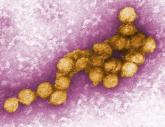News

EXPERT ANALYSIS FROM A CONFERENCE ON PEDIATRIC INFECTIOUS DISEASES SPONSORED BY THE CHILDREN'S HOSPITAL COLORADO
VAIL, COLO. – The number one cause of pediatric neuroinvasive arboviral disease in the United States turns out to be – to the surprise of most physicians – La Crosse virus.
That’s right. Not West Nile, but La Crosse.
West Nile infections draw most of the national attention and fear, and rightfully so. A total of 10,237 cases of West Nile meningitis, encephalitis, or myelitis in children and adults were reported to ArboNET, the Centers for Disease Control and Prevention’s (CDC’s) national surveillance system, between 2003 and 2011. That’s over 10 times more than the combined number of reported cases of neuroinvasive disease caused by the other arthropod-borne viruses or arboviruses: La Crosse virus, eastern equine encephalitis virus, St. Louis encephalitis virus, and Powassan virus, Dr. Marc Fischer said at a conference on pediatric infectious diseases sponsored by the Children’s Hospital Colorado.
Cases of neuroinvasive La Crosse virus disease outnumber West Nile virus disease in the pediatric age group because the age distribution of the infections is dramatically different. While fully 88% of all cases of neuroinvasive disease caused by La Crosse virus occurred in patients under age 18, that was true for only 4% of cases of West Nile neuroinvasive disease, noted Dr. Fischer, a medical epidemiologist at the CDC’s Arboviral Disease Branch in Fort Collins, Colo.
This translates to an average annual incidence of 0.9 cases of La Crosse virus neuroinvasive disease per million U.S. children and adolescents for 2003-2011, compared with 0.63 cases per million for West Nile virus. Trailing far behind are eastern equine encephalitis virus at 0.04 per million, followed by Powassan virus and St. Louis encephalitis virus, tied at 0.01 cases of neuroinvasive disease per million individuals under age 18, he reported.
These incidence figures greatly underestimate the actual risk of these diseases in regions where the arboviruses are endemic. La Crosse virus, for example, is extremely focal in its distribution. During 2003-2011, more than 80% of all cases of La Crosse virus pediatric neuroinvasive disease were reported from four states: Ohio, West Virginia, North Carolina, and Tennessee.
"These are the states where you really need to be thinking about La Crosse virus when you have a child with meningitis or encephalitis," Dr. Fischer said.
In contrast to the other disease-causing arboviruses, West Nile virus is endemic all across the country. Yet it, too, is focal in its distribution. While cases of West Nile virus pediatric neuroinvasive disease were reported from nearly every state during 2003-2011, those cases occurred in only about 8% of the more than 3,000 U.S. counties in the continental United States.
Nationally, the annual incidence of both West Nile and La Crosse virus pediatric neuroinvasive disease dropped steadily through 2007 from a peak in 2003. Since 2007, however, reported La Crosse virus disease cases have increased, while West Nile cases have continued to drop. However, in 2012 there have been more reported cases of West Nile virus neuroinvasive disease to date than on the same date in any year since 2004, with most of the activity being concentrated in Texas, Oklahoma, and Mississippi, according to Dr. Fischer.
The clinical syndrome of pediatric arboviral disease tends to be expressed differently depending upon whether the infectious agent is La Crosse or West Nile virus. In all, 78% of La Crosse cases reported to ArboNET in 2003-2011 were classified as encephalitis and 20% were meningitis, while West Nile virus cases were split 47% encephalitis and 50% meningitis.
The most lethal pediatric neuroinvasive arboviral disease is eastern equine encephalitis virus infection, with a 38% mortality rate. It’s such a rare disease, however, that this very high mortality rate translated to only 26 deaths nationwide in 2003-2011. The mortality rate was just 1% each for La Crosse and West Nile virus pediatric neuroinvasive disease.
The clinical spectrum of most domestic arboviral infections follows the same general pattern: 70%-80% of infections are asymptomatic, 20%-30% result in a generally self-limited, systemic, flulike febrile illness, and less than 1% of infections result in neuroinvasive disease.
Diagnostic laboratory testing for suspected neuroinvasive arboviral disease entails testing for IgM antibodies in the serum or cerebrospinal fluid (CSF), then confirmatory testing for neutralizing antibodies. Commercial IgM antibody assays for West Nile virus are readily available. Physicians have three options for testing for the other arboviruses: a commercially available immunofluorescent assay kit marketed by Focus Diagnostics; most state health departments will perform testing; and the CDC accepts specimens for testing at its Fort Collins laboratory.

